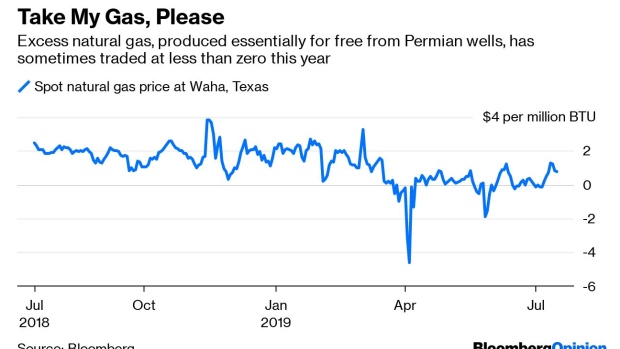Jul 18, 2019
Saturday Will Be Hot. Oil and Gas Will Be Not
, Bloomberg News

(Bloomberg Opinion) -- Saturday is shaping up to be national air-conditioner day. And while we ordinary humans love a “heat dome” about as much as a “polar vortex,” natural gas bulls should be all over that surge in electricity demand. But they’re nowhere to be seen.
“Cooling-degree days” are a measure of how hot it is relative to normal. Since July 2011, when the data series begins on the Bloomberg Terminal, there have been 22 weeks where the forecast for cooling-degree days was 90 or more (translation: hot). This week, coming in at 93, is one of them. But with natural gas currently hovering at about $2.30 per million BTU, it also scores as the weakest week in terms of pricing.
This summer of more heat than light is a microcosm of the broader problem facing the exploration and production business. And it’s a searing reminder of some salient points as quarterly earnings calls beckon.
Natural gas prices have been moribund for a while. Having cracked the code on shale first, resurgent U.S. gas supply overwhelmed demand growth years ago. The migration of fracking to oil – which tends to bring a lot of associated gas with it – exacerbated this. At several points this year, gas has changed hands in west Texas at negative prices; in other words, producers have paid customers to take it off their hands.
Price-insensitive gas production, as well as shale’s relatively short development schedule, is why even a heatwave does little for the market. Inventory may be running a bit below average for this time of year (although the gap has been shrinking since March). But why worry when there’s a seemingly endless supply of the stuff coming up in ever bigger quantities from fracked wells?
Oil producers suffer similarly from too much of a good thing. U.S. crude oil output is forecast to surge this year – just as it did last year. And 2020 is shaping up for a big increase, too.
This is why, just as the prospect of sweaty armpits does nothing to arouse passions in the gas market, oil prices are seemingly impervious to the usually trusty aphrodisiacs of OPEC cuts and threats of war (ominous economic data and trade conflicts haven’t helped either).
The sheer indifference to oil and gas is evident not just in the energy sector’s miserable sub-5% weighting in the S&P 500 Index, but also the futures markets for the commodities themselves.
Hedge funds’ net length in the three big crude oil contracts combined has dropped sharply since April, back toward the depths plumbed in January and February, when Brent was about $10 lower than today. More telling, perhaps, is the slump in open interest in general, with analysts at JBC Energy noting in a report this week that speculative positions in the Nymex West Texas Intermediate benchmark are at their lowest level since 2013. The picture looks a bit better when considering the big three together, but not much:
The combination of shale, OPEC, Iranian saber-rattling, Trumpian tweeting, and trade tiffs has made betting on oil’s direction a hazardous and ultimately unpopular pursuit. As for speculative interest in natural gas, combined positions hit their lowest point in almost eight years in February, but have since expanded – all on the short side.
Harsh as it may sound, the lesson oil and gas companies should draw from this is that no one cares about their oil and gas (not in the sense of investing, anyway). Which means one of the big reasons to own an E&P stock – a leveraged bet on oil and gas prices – is now a very small reason. Highly leveraged producers at the mercy of the oil and gas gods, such as Chesapeake Energy Corp. and California Resources Corp., may have offered a wild ride but not much else.
So when producers lay out guidance for the second half of the year, investors will want to hear a message of restraint; taking it easy rather than ramping up production into a market that doesn’t need it. Giving free cash flow to investors, rather than free rein to frack crews, is the advisable option at this juncture. The industry largely took the opposite approach this time last year, taking a short, sharp rally in oil prices as a cue to bust through spending budgets. Investors responded with a year-end sell-off.
The best way for E&P executives to spend this summer: play it cool.
To contact the author of this story: Liam Denning at ldenning1@bloomberg.net
To contact the editor responsible for this story: Mark Gongloff at mgongloff1@bloomberg.net
This column does not necessarily reflect the opinion of the editorial board or Bloomberg LP and its owners.
Liam Denning is a Bloomberg Opinion columnist covering energy, mining and commodities. He previously was editor of the Wall Street Journal's Heard on the Street column and wrote for the Financial Times' Lex column. He was also an investment banker.
©2019 Bloomberg L.P.


